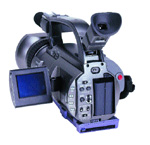
JVC's Streamcorder is a pro DV camcorder with the ability to record to tape as well as to digital memory or simultaneously stream to the Internet. (See story on page 54.)
|
"Last year, with the devaluation of the stock market and Internet companies, some good business ideas were devalued too," says Geoff Allen, chief executive officer of Anystream (www.anystream. com). "Streaming was more hyped than it should have been, but you can make money with it. Mature businesses are saying, 'Why aren't we using streaming to do this?"
Allen reports that Anystream, a provider of software for automating the production and distribution of streaming media, is experiencing "more activity than we've ever seen. Some large, high-profile applications are among the biggest we've ever done. And three out of four are content revenue-generating operations. We support them by allowing them to take content they already have and put it online." According to Allen, Digital Island's entire streaming production operation is based on Anystream software, and the Anystream products also form the backbone of BT Broadcast Services' streaming efforts.
"We realize we can't push customers to make decisions on what's critical to business in this climate," Allen notes, however, "we've identified what existing customers are doing, and we communicate that to similar potential customers. But we recognize we can't really push the market. It's not a matter of re-educating people about streaming but focusing our activities by listening to our customers."
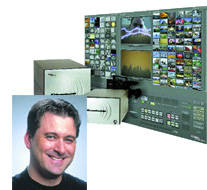
GlobalStream's Daniel Kaye on his company's OnQ system, which uses the Internet to deliver a video presentation live or on demand: "We're creating a new kind of TV, accessible to every business professional."
|
ANYSTREAM: AGILITY WORKGROUP
When Anystream unveiled Agility Workgroup, a modular, scalable product line of streaming automation software, other software solutions were "dramatically more expensive and less functional," Allen says. "We launched with a top-of-the-line product, now Agility Workgroup XE, with everything, and it did very well with early adopters. Pre-NAB 2001, there was a big chasm between ourselves and products like Media Cleaner Pro. So we announced Agility Workgroup SE, with no live input capabilities, and it did very well and continues to do very well.
"We heard later that SE customers were buying a copy of Adobe Premiere and a video capture card for deck control and exporting to SE. So we introduced Workgroup CE with full deck control and full SE functionality. It's become our most popular configuration by far, our number one seller."
Last fall, Anystream introduced Agility 2.0, which added performance enhancements and functionality across the board: Agility Workgroup SE gained folder attendant ,which lets networked clients drag-and-drop media files into a continually monitored folder for automatic processing and distribution. Agility Workgroup XE added live Webcasting capabilities, which also became an option with the other packages.
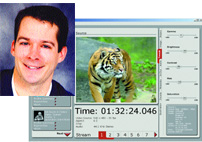
Anystream offers a full line of streaming automation software and recently introduced version 2.1 of its Agility Enterprise open-architecture product, which targets broadcasters. (CEO Geoff Allen is inset.)
|
Prior to NAB 2002, Anystream will announce version 2.1 of Agility Enterprise. Its flagship, open-architecture product used by Fox News, Fox Sports, Weather.com, CNN, NFL Films and others. The new release provides a number of enhancements for broadcasters, including support for native file formats for news producers.
"We've always been a high-performance software company," Allen notes. "Every quarter we see performance and video-quality improvements." He says Anystream supports Microsoft and Packet Video's versions of MPEG-4 and is listening to customers' needs for additional format support.
Allen believes the market requires "broader, more modular product offerings. People say many products are too complex, expensive and difficult and don't do enough. Our MO has been to make products broader, more integrated and easier to use."
GRASS VALLEY GROUP: WEBABLE, AQUA
"People who thought they could put a shingle out and turn over millions of dollars on streaming in just months were sadly mistaken," observes Ross Summers, director of business development/Internet for Grass Valley Group (www.grassvalleygroup.com), which is in the process of being acquired by Thomson. "Those who experimented and took big gambles with content, who were undirected and didn't have real sound business plans, took it on the chin. So did people who built infrastructure and facilities to do large-scale encoding and who haven't seen a rush to it.
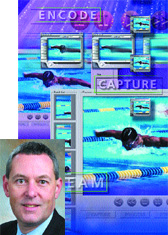
According to Grass Valley's Ross Summers (inset), Aqua's One Pass Encoding technology lets users preprocess, capture, clean and encode an input source and render it into multiple streaming formats at multiple bit rates in realtime.
|
"But a good, conservatively-run business can make money in streaming," he reports. "The appetite for streaming is growing now, and it's more focused. There's more interest from people in the general business space who are using streaming as a communications or educational vehicle. And we see interest from our broadcast customers and major telcos worldwide."
Since last summer, Grass Valley has been shipping its WebAble tool suite. WebAble features a drag-and-drop method for creating streaming media from the content of a Profile XP Media Platform and assets located by Grass Valley's ContentShare, a software platform for media asset management. It streamlines the process used by broadcasters, video professionals and e-commerce providers to repurpose their Profile high-resolution video content for Webcasting and Web distribution.
"WebAble is intended more for offline use with existing assets," notes Summers. "Customers can play to air with Profile then, with WebAble, take the portion of the content they want to make available over the Internet, cut the clip and convert it to a streaming format."
The company's Aqua Internet encoder will be shipping this spring. A stand-alone device, Aqua can work in conjunction with Profile or another video server or video source. It's suited for live streaming, VOD (video on demand) or archiving.
"Our focus with Aqua was to build the most robust product possible, a product which would meet the performance needs of the realtime arena," says Summers. "If Aqua did well there, we knew it would be fine for on-demand and archiving applications. We also wanted to make sure Aqua fit into existing workflows without reinventing the way people do things and without the need for retraining."
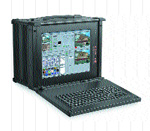
Pinnacle's StreamGenie Presenter is a portable Webcasting solution for delivering live, rich media streaming presentations over the Internet. It will be demonstrated at NAB.
|
Aqua's One Pass Encoding technology lets users preprocess, capture, clean and encode an input source and render it into multiple streaming formats at multiple bit rates, all in realtime. Architected to be codec independent, Aqua currently supports the major streaming media formats: Microsoft Windows Media, RealNetworks' RealVideo and Apple QuickTime. Support for additional codecs, including MPEG-4, will be added over time.
PINNACLE SYSTEMS: STREAMGENIE, STREAM FACTORY
"When Pinnacle Systems got into streaming about two years ago," recalls Greg Lowitz, GM of content delivery solutions, "streaming was clearly driven by the dot.com explosion. The dot.coms wanted to know how to monatize streaming over the Internet to the consumer. People, including us, jumped on the bandwagon and looked at streaming as the next broadcast medium.
"That's still true, but the models have not emerged to make streaming cost effective to deliver to consumers unless it's subscription delivery of premium content," he concludes.
In anticipation of content delivery to consumers, the infrastructure "got way overbuilt," Lowitz notes. That means the price per stream has dropped but the infrastructure builders have suffered because "the dollar volume is not there to support their spending."
After Pinnacle Systems (www.pinnaclesys.com) had been in the streaming business for a few months it realized the business model for consumer streaming was still way down the road. "So 12 months ago we switched emphasis to the corporate enterprise market," Lowitz reports. "The model there is using streaming to save money in the corporate environment."
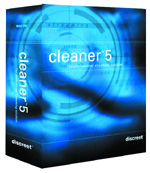
Discreet's Cleaner Central is a network renderer that automates the workflow to distribute a Cleaner batch across multiple machines or a network.
|
Pinnacle Systems has shipped some 1,200 content delivery solutions to corporate customers worldwide. StreamGenie Presenter is a portable Webcasting solution for delivering live, rich media streaming presentations over the Internet. It supports multiple camera switching, simultaneous output of Real and Windows Media streams, integrated professional titling, graphics, 3D effects and professional audio as well as synchronized PowerPoint presentations. StreamFactory with HiQ preprocessing is a turnkey realtime media encoder for high-quality Internet streaming. Its MultiStream technology allows users to create up to four independent master streams of Real and/or Windows Media at the same time from the same input. StreamFactory X2 delivers twice the encoding horsepower and is suitable for broadband encoding requirements.
"Even before Sept. 11 people were increasing their use of live and on-demand streaming to supplement their internal corporate communications activities," Lowitz explains. Hewlett Packard uses StreamGenie for corporate Webcasts and Chevron/Texaco employed StreamGenie and StreamFactory to announce its merger in a Webcast to employees and the media. Home Depot also taps StreamFactory for executive briefings and to stream weather information to its stores, since business is often driven by customers preparing for various weather conditions from hurricanes to heat waves to blizzards.
At NAB Pinnacle Systems plans to deliver a collaborative and integrated workflow message for all its products. "More and more focus is on workflow; for example, how StreamFactory can integrate more closely with nonlinear editing systems for batch encoding of content," Lowitz says. "We'll have products and solutions that leverage the existing hardware platform and software that automates the process to get customers online efficiently." Pinnacle will also continue to make incremental hardware improvements in speed and performance.
DISCREET: CLEANER, CLEANER CENTRAL
"We're seeing an interest from the post production market in streaming for review and approval between clients and post houses," says Dion Scoppeltuolo, product marketing manager for editing, infrastructure and streaming at Discreet (www.discreet.com). Post customers typically use Cleaner, which converts files to all popular streaming formats up to MPEG-2, to stream work in progress on demand.
"Many Avids ship with CleanerEZ, which supports all formats via our presets," notes Joe Klingler, Discreet's senior director of software engineering for streaming products. "Editors using Media 100i set up a transcoding task and it runs the full retail version of Cleaner."
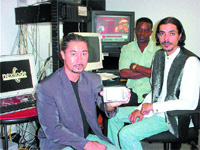
"When you download our player/software it turns your computer into a server," explains CTO Caesar Collazo (far right), who is pictured with (L-R) COO Michael Brown and CEO Nana Yalley.
|
The corporate market is increasingly taking up streaming as a communications tool for everything from CEO messages to financial reports, Klingler adds. Cleaner's edge is "it supports a broad range of formats, delivers the best quality possible from compressed media and offers EventStream interactive authoring," he notes, adding, "streaming will first revolutionize the workflow and the way people do business. Later it will be developed for revenue generation and delivery to your home entertainment center."
Discreet's Cleaner Central will have its first showing at NAB. A network renderer for Cleaner, Cleaner Central automates the workflow to distribute a Cleaner batch across multiple machines or a network providing higher throughput and lower latency. As a standalone, custom, interoperable and Cleaner-compatible system, Cleaner Central was developed to fully leverage the skills of today's artists.
The cost effective Cleaner Central is scalable from a standard two-node (computer) system to 20, although there is no real limitation on Cleaner Central apart from the infrastructure around it. "Users can be a single editor or producer who wants speed or a larger studio, facility or corporate enterprise," says Scoppettuolo.
Discreet has also been busy with software upgrades for Cleaner. February's release of Cleaner 5.1 supports the latest Windows Media encoders. And Cleaner 5.1.1 for the Mac OSX became available this month. Klingler expects Discreet products to begin supporting MPEG-4 later this year.
GLOBALSTREAMS: OnQ, GLOBECASTER
"In the wild days of the Internet anything was up for grabs," recalls Daniel Kaye, VP of product development at GlobalStreams (www. globalstreams.com). "But today there's a changing focus. Companies need to improve business, to make and save money. That's great for our products, which help companies communicate better with affordable solutions."
Kaye notes that when GlobalStreams did a prelaunch of OnQ at Comdex last November, the convention was light in attendance in the aftermath of September 11 but those present gave him "a very strong message that OnQ was on the right track. What caught their attention was OnQ's potential to eliminate the need to travel to deliver a presentation." OnQ combines video, audio, pictures, Microsoft PowerPoint presentations and Web pages to make effective presentations in one easy-to-use desktop tool.
"OnQ allows you to use the Internet to deliver a video presentation live or on demand with audio and video as well as other elements such as Web content. It's a one-to-many video presentation system which lets you present as if you were right there face to face with your audience," explains Kaye. "We're enabling a lot of people to do what has not been practical or even possible before."
GlobalStreams has leveraged its philosophy of maintaining high video production values - found in the company's GlobeCaster product line - in designing OnQ. "OnQ has a broadcast-quality look complete with titles and over-the-shoulder graphics so even though the presentation is streaming over the Internet it has a TV look and feel," Kaye says. "We're creating a new kind of TV accessible to every business professional."
OnQ software is priced at about $1,000 and includes a bundled Media Station video capture unit.
In addition to OnQ, GlobalStreams will also be showing its three-product GlobeCaster line at NAB. GlobeCaster Studio is an all-in-one-box solution with all the tools necessary for a complete broadcast via TV, cable, satellite and the Internet. GlobeCaster Post is a hybrid realtime linear and nonlinear editing system. GlobeCaster Live is designed for live broadcast output to TV, cable, satellite and the Internet.
NEXCODE: NETDVD
After Nexcode Inc. started to demo its NetDVD (Network Digital Versatile Delivery) product about six months ago, most of the major networks decided to pull their live streams off their Web site and began offering only VOD, notes Caesar Collazo, Nexcode's chief technical officer.
Perhaps the networks may have thought their live streams suffered by comparison with the NetDVD application. NetDVD is a fast and clear realtime video and audio compression methodology. Reportedly twelve-times faster than any other currently-available delivery system, NetDVD permits the DVD-quality delivery of compressed digital content at 24 to 30 frames per second along with the optional 5.1 Dolby Digital Surround Sound for either live video streaming or VOD. Consumers may download and install NetDVD basic for free at www.nexcode.tv; they are then able to access content distributed via the NetDVD network system whether by cable modem, DSL or dialup.
"When you download our player/software it turns your computer into a server," explains Collazo. "You serve directly from server to server. The more people who use NetDVD, the more servers we have on our network. The network scales depending on popularity. Take for instance a live Pay Per View Webcast event for over a million people. The question is, what if each person was a mirrored server? In theory, you'd have a flawless PPV event."
NetDVD is built around a proprietary process that can be viewed using any player including Apple QuickTime, Windows Media Player and RealPlayer. The application also offers flexible and scalable video delivery streams to Pocket PCs, PDAs and Macintosh and Linux systems.
Collazo reports that NetDVD is "the only methodology processing 30 fps for both VOD and live streams. People use the term 'live' too loosely on the Internet," he says. "They claim to be streaming live on the Internet when, in reality, they are delivering VOD. Most streaming companies deliver blurry, mediocre and less-than-desirable video quality. People are accustomed to the slide-show look of video streaming until they see the NetDVD network delivery, and then they say, 'Wow!'"
NetDVD's first target users will be "consumers who desire to control and share multimedia content over any network including the Internet." Says Roger Paglia, CEO of Nexcode's parent company Media & Entertainment.com, Inc., "Because the NetDVD application is capable of delivering packets via a LAN/WAN and various Intranet infrastructures, the entertainment and broadcasting industries and the corporate market also stand to be early adopters."
Nexcode, which will not be at NAB this year, will generate revenues for itself from the sale of modules which can be integrated with NetDVD to create "a massive solution," says Nexcode CEO Nana Yalley. "People can purchase plug-ins such as corporate teleconferencing modules or a PPV module for tracking subscribers. For review and approval of edits and dailies the Avid and Media 100 editing workstations' plug-ins are in development for release in the third quarter of 2002."